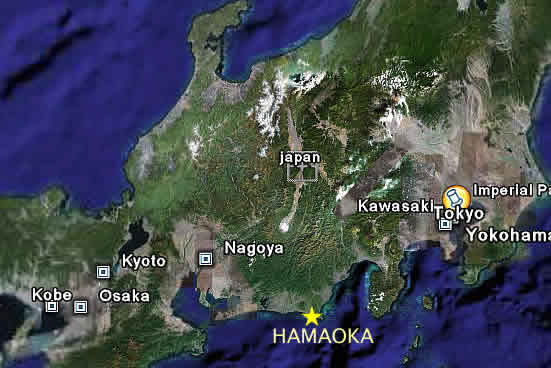Suzuki Moves Away From The Water - But Will It Have Power?

Suzuki is not buying into the „once in a millennium tsunami.” Suzuki has a lot of its production near the waterfront in Japan’s Tokai region. Scientists give the area between Toyko and Nagoya an 87 percent chance of getting hit by an earthquake with a magnitude of about 8 within the next 30 years. Suzuki’s answer: Let’s get out of here, fast.
According to The Nikkei [sub], Suzuki will spend 40 billion yen ($500m) and move its production to higher ground and 10 kilometers (6.2 miles) inland. Suzuki plans to acquire a roughly 270,000 sq. meter plot in Hamamatsu. Hamamatsu happens to be the city where Suzuki was founded.
The new site is about 50km (31 miles) from the Hamaoka nuclear power plant. The plant has been shut down and will only be allowed to re-start once huge seawalls and other improvements have been built. According to experts, this will take many years.
And this is where the bigger problem is. Japan and especially the Japanese industry may skate through this summer with a lot of perspiration, but without major power outages. The big outages loom next year. 35 of Japan’s 54 reactors are down. Attempts to re-start them are being stopped by politicians. Just yesterday, Prime Minister Naoto Kan gave an order to not restart power plants unless unspecified “stress tests” are performed. However, within a year, all remaining power plants have to be shut down for routine maintenance. Nobody wants to sign-off on a delay of the maintenance either. Which would leave Japan without nuclear power next year.
Far away from Fukushima, on the southwesternmost island of Kyushu, Kyushu Electric Power has shut three reactors for regular inspections. They cannot be restarted due to the government edict. Nissan has a factory in Kyushu, Toyota has two factories there.

Bertel Schmitt comes back to journalism after taking a 35 year break in advertising and marketing. He ran and owned advertising agencies in Duesseldorf, Germany, and New York City. Volkswagen A.G. was Bertel's most important corporate account. Schmitt's advertising and marketing career touched many corners of the industry with a special focus on automotive products and services. Since 2004, he lives in Japan and China with his wife <a href="http://www.tomokoandbertel.com"> Tomoko </a>. Bertel Schmitt is a founding board member of the <a href="http://www.offshoresuperseries.com"> Offshore Super Series </a>, an American offshore powerboat racing organization. He is co-owner of the racing team Typhoon.
More by Bertel Schmitt
Latest Car Reviews
Read moreLatest Product Reviews
Read moreRecent Comments
- Funky D The problem is not exclusively the cost of the vehicle. The problem is that there are too few use cases for BEVs that couldn't be done by a plug-in hybrid, with the latter having the ability to do long-range trips without requiring lengthy recharging and being better able to function in really cold climates.In our particular case, a plug-in hybrid would run in all electric mode for the vast majority of the miles we would drive on a regular basis. It would also charge faster and the battery replacement should be less expensive than its BEV counterpart.So the answer for me is a polite, but firm NO.
- 3SpeedAutomatic 2012 Ford Escape V6 FWD at 147k miles:Just went thru a heavy maintenance cycle: full brake job with rotors and drums, replace top & bottom radiator hoses, radiator flush, transmission flush, replace valve cover gaskets (still leaks oil, but not as bad as before), & fan belt. Also, #4 fuel injector locked up. About $4.5k spread over 19 months. Sole means of transportation, so don't mind spending the money for reliability. Was going to replace prior to the above maintenance cycle, but COVID screwed up the market ( $4k markup over sticker including $400 for nitrogen in the tires), so bit the bullet. Now serious about replacing, but waiting for used and/or new car prices to fall a bit more. Have my eye on a particular SUV. Last I checked, had a $2.5k discount with great interest rate (better than my CU) for financing. Will keep on driving Escape as long as A/C works. 🚗🚗🚗
- Rna65689660 For such a flat surface, why not get smoke tint, Rtint or Rvynil. Starts at $8. I used to use a company called Lamin-x, but I think they are gone. Has held up great.
- Cprescott A cheaper golf cart will not make me more inclined to screw up my life. I can go 500 plus miles on a tank of gas with my 2016 ICE car that is paid off. I get two weeks out of a tank that takes from start to finish less than 10 minutes to refill. At no point with golf cart technology as we know it can they match what my ICE vehicle can do. Hell no. Absolutely never.
- Cprescott People do silly things to their cars.


































Comments
Join the conversation
If I remember correctly what I read recently, Swiss are also going to phase-out their nuke industry. Despite what negatives anybody might have to say about them, Swiss are not much in the way 2nd-hand panic monkeys.
I am generally pro-nuclear power. However when it comes down to it's all the about the waste. Fix that problem and we have something, but storing it for ever is not viable. And in the case of Fukushima, TEPCO presumably in the absence of somewhere to dispose of said waste, decided that storing it on top of the reactor was a good idea.